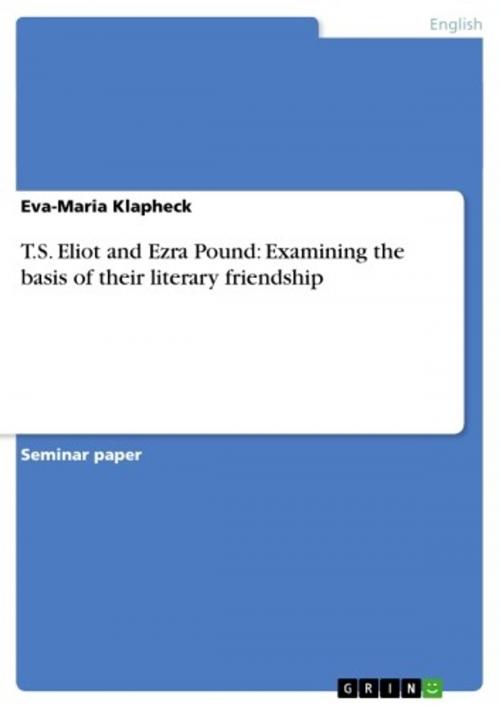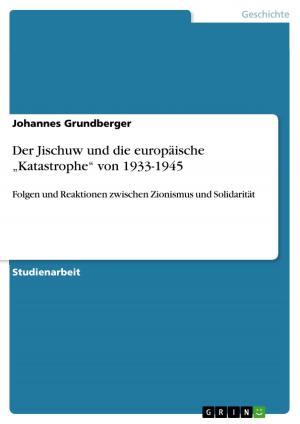T.S. Eliot and Ezra Pound: Examining the basis of their literary friendship
Nonfiction, Entertainment, Drama, Anthologies| Author: | Eva-Maria Klapheck | ISBN: | 9783638315289 |
| Publisher: | GRIN Verlag | Publication: | October 14, 2004 |
| Imprint: | GRIN Verlag | Language: | English |
| Author: | Eva-Maria Klapheck |
| ISBN: | 9783638315289 |
| Publisher: | GRIN Verlag |
| Publication: | October 14, 2004 |
| Imprint: | GRIN Verlag |
| Language: | English |
Seminar paper from the year 2003 in the subject American Studies - Literature, grade: 2,0 (B), University of Duisburg-Essen (Institute foreign language philology), course: Modernism and the Poetry of Ezra Pound, 20 entries in the bibliography, language: English, abstract: The literary friendship between Ezra Pound and T.S. Eliot is a great example of a fruitful and influential collaboration of two American poets of the twentieth century. The writers met in 1914 as exiles in Europe where they discovered a mutual commitment to the arts, and foremost to the revitalising of poetry. Their letters, conversations, essays, and poems flow together to form a single commentary on the literary tradition as well as the accomplishments of their time. According to many critics, it is Ezra Pound's editing of the manuscript of T.S. Eliot's The Waste Land that contributed to the poem's becoming a masterpiece of modern poetry. Moreover, this collaboration constituted the climax of their astonishing series of close interactions. Their common endeavours made them the driving force behind modernism in the English and American poetry of the twentieth century. This analysis critically discusses the various fields where the common ground of their lifelong literary friendship is evident. Further, it will give a coherent account of the reasons as well as the results of their close collaboration. This will be exemplified on the basis of the significant essays, letters and poetic work of both that was produced during the period of Eliot and Pound's immense interaction between 1914 and the publishing of The Waste Land in 1922. The essay is structured as follows: It begins with an explanation of Pound and Eliot's motives for their exile in Europe. The central biographical facts on both poets are included for clarification. In addition, the chapter sets Pound in context to William Carlos Williams, who decided in the frequent stay-or-put controversy at that time in favor of America. The next chapter examines the common features of their literary theory and criticism. It deals with their common approach to the literary tradition, as well as with the literary models by which they were strongly influenced. Therefore, it mainly takes into consideration the central essays by Pound and Eliot. Further, an excursus on their relation to Walt Whitman is included. Finally, the assignment illustrates the nature of their collaboration concerning The Waste Land. Additionally, the chapter takes a close look on the reception as well as the publishing history of Eliot's long poem. The essay ends with a conclusion that sums up the main points.
Seminar paper from the year 2003 in the subject American Studies - Literature, grade: 2,0 (B), University of Duisburg-Essen (Institute foreign language philology), course: Modernism and the Poetry of Ezra Pound, 20 entries in the bibliography, language: English, abstract: The literary friendship between Ezra Pound and T.S. Eliot is a great example of a fruitful and influential collaboration of two American poets of the twentieth century. The writers met in 1914 as exiles in Europe where they discovered a mutual commitment to the arts, and foremost to the revitalising of poetry. Their letters, conversations, essays, and poems flow together to form a single commentary on the literary tradition as well as the accomplishments of their time. According to many critics, it is Ezra Pound's editing of the manuscript of T.S. Eliot's The Waste Land that contributed to the poem's becoming a masterpiece of modern poetry. Moreover, this collaboration constituted the climax of their astonishing series of close interactions. Their common endeavours made them the driving force behind modernism in the English and American poetry of the twentieth century. This analysis critically discusses the various fields where the common ground of their lifelong literary friendship is evident. Further, it will give a coherent account of the reasons as well as the results of their close collaboration. This will be exemplified on the basis of the significant essays, letters and poetic work of both that was produced during the period of Eliot and Pound's immense interaction between 1914 and the publishing of The Waste Land in 1922. The essay is structured as follows: It begins with an explanation of Pound and Eliot's motives for their exile in Europe. The central biographical facts on both poets are included for clarification. In addition, the chapter sets Pound in context to William Carlos Williams, who decided in the frequent stay-or-put controversy at that time in favor of America. The next chapter examines the common features of their literary theory and criticism. It deals with their common approach to the literary tradition, as well as with the literary models by which they were strongly influenced. Therefore, it mainly takes into consideration the central essays by Pound and Eliot. Further, an excursus on their relation to Walt Whitman is included. Finally, the assignment illustrates the nature of their collaboration concerning The Waste Land. Additionally, the chapter takes a close look on the reception as well as the publishing history of Eliot's long poem. The essay ends with a conclusion that sums up the main points.















